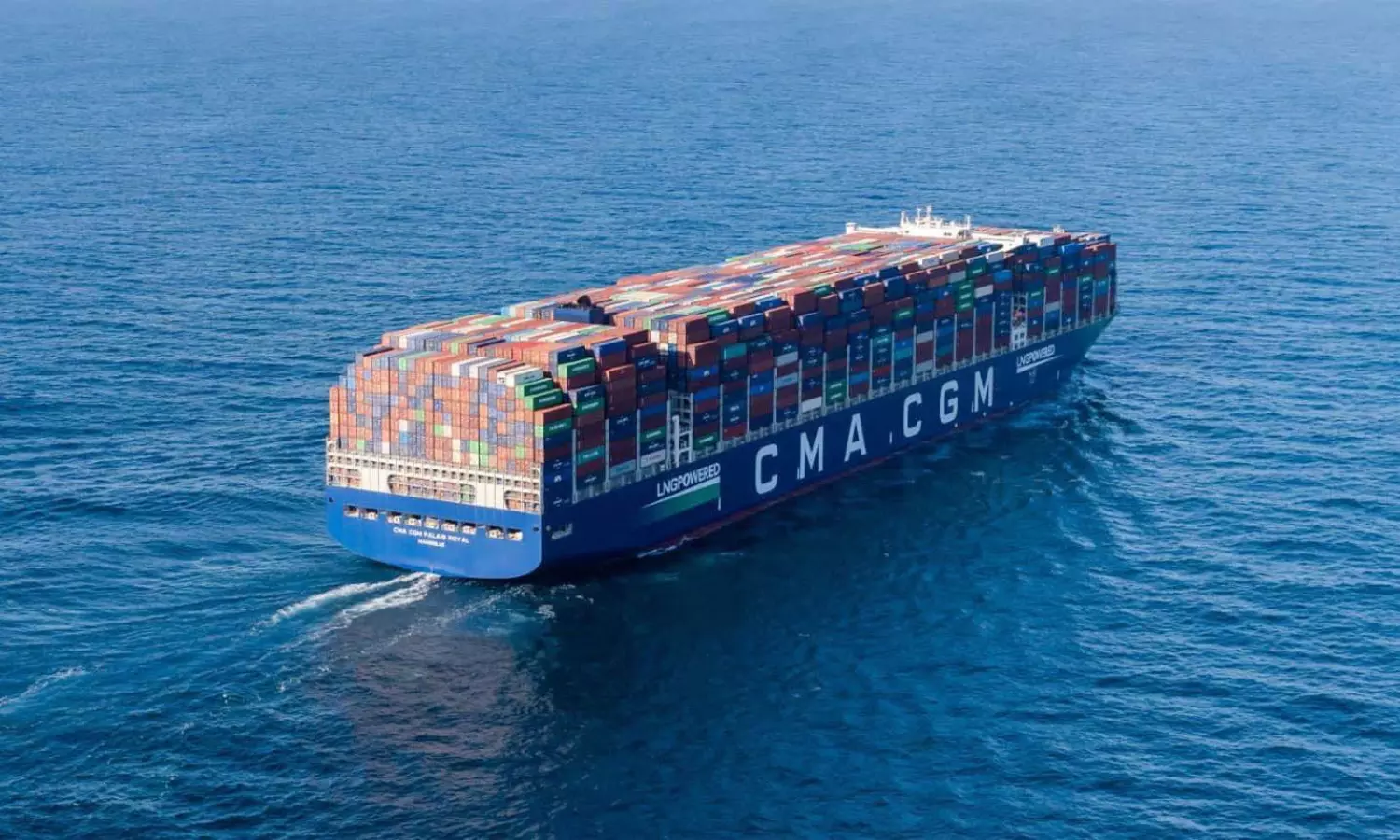#RedSeaImpact: Spot rates zoom, longer lead times ahead
MSC introduces a new acronym - contingency adjustment charge (CAC), Maersk, CMA CGM announce diversions

The impact of attacks on container ships transiting the Red Sea and the resulting mass diversions around the Cape of Good Hope saw Drewry’s World Container Index increase nine percent to $1,661 per 40ft container.
"The latest Drewry WCI composite index of $1,661 per 40ft container is now 17 percent more than average 2019 (pre-pandemic) rates of $1,420. The average composite index for the year-to-date is $1,674 per 40ft container, which is $998 lower than the 10-year average rate of $2,672 (which was inflated by the exceptional 2020-22 Covid period)."
Shanghai to Rotterdam spot rates zoomed 16 percent week-on-week to $1,667 per 40ft while rates from Shanghai to Genoa increased 15 percent to $1,956. Drewry is expecting East-West spot rates to increase in the coming weeks due to the Red Sea/Suez situation.
"These unexpected spot rate jumps, caused by geopolitics and despite an over-capacity glut, are too late to influence 2024 Asia-Europe contracts," says Philip Damas, Head of Supply Chain Advisors practice and Managing Director, Drewry Shipping Consultants, in his LinkedIn post. "Contract rates on this route have been negotiated and finalised at much lower levels based on inputs into the Drewry Benchmarking Club, a community of 100+ retail and manufacturing multinationals.
"Now, everyone will need to monitor the situation of the Red Sea attacks and how long the situation persists. In China, forwarders and exporters are already concerned that there could be a shortage of China-Europe capacity during the usual pre-Chinese New Year cargo rush."
Michael Aldwell, Board Member, Sea Logistics, Kuehne+Nagel says: "Containerised shipping represents 30 percent of global shipping with an estimated total value of goods transported amounting to $1 trillion. Annually, approximately 19,000 ships navigate through the Suez Canal. The duration of an Asia-Europe voyage typically ranges from 30 to 40 days, subject to variations based on vessel type and deployed speed. An alternative route via the Cape of Good Hope adds about 6,000 nautical miles to the journey.
"Choosing this alternative route from Asia to Europe may extend the journey by 3-4 weeks. Other routes such as the Transpacific might involve different additional transit times. The extended time spent on the water is anticipated to absorb 20 percent of the global fleet capacity, leading to potential delays in the availability of shipping resources. Moreover, delays in returning empty equipment to Asia are likely to pose challenges, further impacting the overall reliability of supply chains.
"Currently, we have note of 158 container vessels being stopped or re-routed, with a TEU capacity involved of approximately 2.1 million. Based on comprehensive seaexplorer data, Kuehne+Nagel's Schedule Reliability report already observes a notable decline in global on-time performance in sea freight during November 2023. The on-time performance of carrier schedules has decreased by eight percentage points to 60.8 percent. This trend is observed across all major trade lanes, except for the Transpacific route. The situation in the Red Sea is now exacerbating the challenges faced in this regard."
(Seaexplorer data December 21, 2023)
Outlook not bleak
Unlike 2021’s Suez Canal blockage, there are some mitigating factors that may reduce broader industry impact, according to Freightos:
Timing: December and early January are typically slow freight seasons, creating more buffers.
Exceptional 2021 conditions: In 2021, port congestion was already bad, and the industry had no excess available vessels to address the disruption and maintain schedules.
Excess capacity: Today, there is a record level of excess capacity due to new, larger, container ships, especially on Asia-Europe lanes, which can be used to maintain schedules by adding more vessels to each service and accommodate longer transit times. Likewise, current oversupply may mitigate the degree to which rates will increase.
Counter activity: The U.S. is leading a 10-nation maritime task force determined to counter the threat and mitigate impact, potentially shortening the disruption.
"Engaging in proactive risk assessment and contingency planning will be essential to navigate these volatile conditions. Given the upcoming tenders being finalised for 2024, companies should ensure that they are aware of market conditions and potential anchoring effects leading to an outsized effect for the duration of 2024."
Flexport put it succinctly: the major choke points of shipping routes are under severe stress.
Why Suez Canal is important for global trade
The Suez Canal is a crucial lane for global shipping with 50-60 vessels of all types transiting each day for about 19,000 per year including about 30 percent of global container traffic and more than a million barrels of crude oil per day. "The Suez Canal is the shortest route for container traffic from Asia to the Mediterranean and Europe, and is also used for some volumes from the Far East or Southern Asia to North America. Diverting around the southern tip of Africa adds 2,500 – 3,500 nautical miles and seven-to-10 days for ships sailing to Northern Europe or North America, and as much as 7,000 nm for some Mediterranean destinations. In addition to time, the fuel implications add up significantly both from a cost perspective and in terms of carbon emissions."
Judah Levine, Head of Research, Freightos says: "Beyond the blip now, the timing, as plans are finalised for 2024, is an important reminder that international freight regularly experiences things you just can’t plan for. Even the recent list is a long one with a mix of some things that could have been somewhat anticipated (eg Hanjin bankruptcy or US tariffs on Chinese imports), some that could not (Covid or the Evergiven blocking the Suez) and some that may have been inevitable (multiple labour strikes).
"In other words, plan but plan for some flexibility. No one could anticipate the Houthis shutting down the Suez Canal a year ago. And that means that the best 2024 plans may not line up with reality either."
Shippers have diverted about $80 billion worth of cargo away from the Red Sea as they face the threat of attacks from Houthi militants in Yemen, CNBC reported.
"Carriers are re-routing vessels as a direct result of 15 strikes in the Middle Eastern body of water since the start of the Israel-Hamas war in October. U.S. Defense Secretary Lloyd Austin announced the formation of an international task force to address security issues."
Xeneta data is showing a rapid increase in the spot market, and major impacts from paused and re-routed transits are expected.
Maersk, CMA CGM announce diversions, MSC, CMA CGM hike prices
"Maersk is continuing to monitor the situation around the Red Sea/Gulf of Aden and making necessary service adjustments in the interest of the safety and security of our vessels, crew, and customers’ cargo onboard," says an official update.
"Our teams have been working hard to ensure operations continue to function as smoothly as possible amid the ongoing geopolitical situation, however an increased security risk means that a number of Maersk and partner vessels have been the subject of temporary route diversions."
Some diversions include Cap San Juan (will sail to Salalah via Cape of Good Hope. Estimated arrival January 15, 2024, Cap San Lazaro (will sail to Port Tangier via Cape of Good Hope. Estimated arrival January 15, 2024) and Edith Maersk (will sail to Port Tangier/WB via Cape of Good Hope. Estimated arrival 15th January 15, 2024.)
Partner vessel diversions include ZIM Hong Kong (will sail to Asia via the Cape of Good Hope on the westbound (WB) rotation. Estimated time of arrival at Xiamen on February 2, 2024.)
Maersk is anticipating delays of between 10-21 days, the update added.
CMA CGM has announced a Red Sea charge for all cargo to and from Red Sea ports. The charges include $1,575 per TEU dry and $3,000 per refeer. It has also announced a contingency charge for several routes.
CMA CGM has also announced diversions of various carriers “currently sailing to and from the U.S., to and from North Europe and to and from Asia or the Indian Subcontinent via the Cape of Good Hope at the southern tip of Africa.”
MSC has introduced a new acronym in container shipping - CAC or contingency adjustment charge, writes Lars Jensen in his LinkedIn post.
“Some of the main ports in Germany like Rotterdam, Hamburg and Bremen are posting significant week on week price increases, and, of course, the interpretation is that the situation in the Red Sea has contributed to this increase," says Christian Roeloffs, Co-Founder & CEO, Container xChange. “The market anticipates that especially in Europe which is on the receiving end of import containers from the Middle East, India, southeast Asia and China that container scarcity will lead to an increase in container prices and the market.”
Tech interventions to the fore
Windward, a maritime AI company, announced the launch of Route Deviation (RDV) Exception, a new capability of Windward's Ocean Freight Visibility solution, to flag route changes caused due to the geopolitical crisis in the Red Sea.
"The new capability provides stakeholders with early alerts of changes to container shipments that have shifted away from entering the Red Sea, enhancing visibility and enabling them to efficiently adapt to changes and mitigate negative outcomes."
Ami Daniel, Co-Founder and CEO, Windward says: "Less than a month into Russia's invasion of Ukraine, we launched our Russia compliance tool. Now we have launched this capability to equip our customers with a first of its kind tool to deal with this unprecedented new challenge. This rapid deployment shows the robustness of our platform and technology and its ability to swiftly adapt to clients' changing needs."
LNG carriers pull out of Red Sea
After containers and tankers, LNG carriers have been compelled to change their initial course by moving away from the Suez Canal and taking longer diversions via the Cape of Good Hope, says an update from Drewry.
"According to Drewry AIS, five LNGCs (including three laden and two ballast) have diverted from the Suez Canal so far. Three of Celsius’ LNGCs (Copenhagen, Charlotte, Geneva) – two chartered by Gunvor have been re-routed since last week. Of which, Celsius Copenhagen is deemed to be carrying LNG from the U.S. Freeport LNG terminal to South Korea while the new destination remains indecipherable."
The longer diversions of shipments via Cape of Good Hope in case of prolonged attacks in the Red Sea could generate extra tonne-mile demand as re-routing of Qatari shipments (Ras Laffan) to Europe from Suez to Cape of Good Hope would increase sailing time by around 80 percent from 15 to 27 days, the update added. "This would also translate into higher shipping costs and longer deployment of vessels. The Red Sea attacks could trigger a jump in LNGC rates due to the longer voyages and the rise in war risk premiums."


